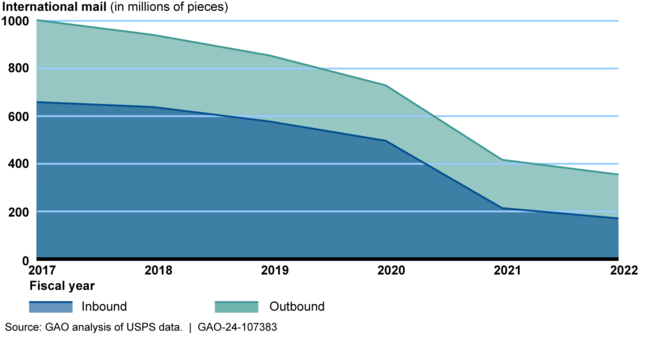International Mail: Effects of Rate Increases and Other Factors on USPS and Domestic Stakeholders
Fast Facts
The United States Postal Service delivers mail to and from countries around the world. In 2017, we reported that USPS lost money delivering international mail to U.S. customers. USPS has been able to cover its costs by increasing certain international mailing rates.
But USPS has handled significantly less international mail since 2017. Stakeholders said that higher mailing rates, COVID-19 restrictions, and new customs laws contributed to less mail.
They also said that these changes benefitted some businesses, like private express companies that offered faster international delivery, but hurt others as rate increases were passed on to consumers.
Mail at the USPS International Mail Service Center in Chicago, IL

Highlights
What GAO Found
The United States Postal Service's (USPS) international mail volume declined from about 1 billion pieces in fiscal year 2017 to about 355 million pieces in fiscal year 2022 (see figure). USPS officials stated that the drop was caused primarily by the implementation of substantially higher rates in 2020. These rates are called “self-declared” rates because the U.S. and other countries were allowed to set their own rates for certain inbound international mail items. USPS's inbound volume subject to self-declared rates fell substantially from fiscal year 2017 to fiscal year 2022. USPS's revenue from international mail also declined over this period but still covered or exceeded its costs.
U.S. Postal Service's (USPS) Inbound, Outbound, and Total International Mail Volume, Fiscal Years 2017-2022

All domestic stakeholders GAO interviewed cited at least one of the following factors as contributing to the decline in USPS's international mail business since 2017.
- International mail rates increased.
- COVID-19 restricted options to get mail in and out of the U.S.
- New customs laws increased costs for sending international mail.
Several stakeholders GAO interviewed said increases in international mail rates likely benefited some businesses and hindered others. They said that express companies, such as FedEx and UPS, may have become more competitive as USPS and other national postal carriers raised their prices for their international mail products. USPS's increases were passed along to U.S. businesses that send mail out of the U.S., making them less competitive. These increases may have been passed on to U.S. consumers. However, stakeholders noted that the effect on consumers is difficult to estimate as mailing rates are not transparent to the consumer and are only one input to the cost of the item.
Why GAO Did This Study
USPS provides postal services to and from other countries through the Universal Postal Union, a specialized agency of the United Nations. This agency established a system for international mailing rates that reimburse postal operators for delivering international mail in their countries. In 2017, GAO reported that USPS lost money on delivering international mail from other countries because mailing rates on small packages did not cover USPS's costs.
GAO was asked to review the effects of increased international mail rates on USPS's international mail business. This report describes: (1) how USPS's international mail business has changed in the past 6 years; (2) what factors domestic stakeholders identified that contributed to those changes; and (3) effects those stakeholders identified from increased international mail rates.
GAO analyzed USPS data from fiscal years 2017 through 2022 and reviewed reports on international mail from USPS, the Universal Postal Union, and others. GAO visited two USPS mail processing facilities and interviewed USPS officials and 12 industry stakeholders. These stakeholders were selected to represent a range of views, including express companies, U.S. companies that send international mail, U.S. companies that compete with foreign firms that use international mail, and independent experts on international mail. While not generalizable, the interviews provide illustrative examples of stakeholders' views. This is a public version of a sensitive report that was issued in February 2024. Information that USPS deemed sensitive has been omitted.
For more information, contact David Marroni at (202) 512-2834 or marronid@gao.gov.
